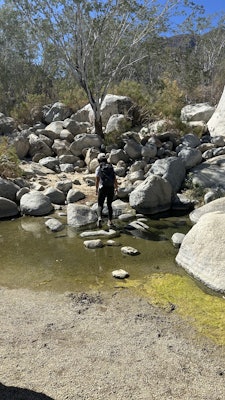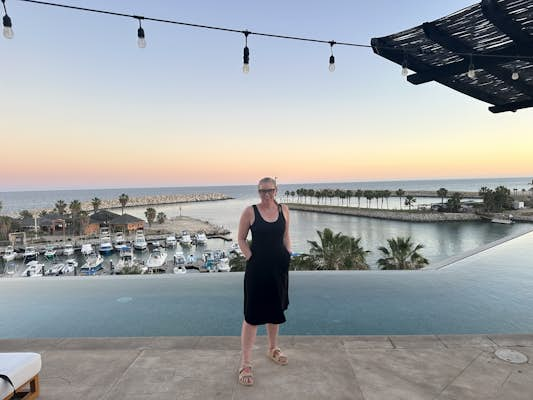The word “Cabo” alone likely conjures visions in your mind of stunning, rocky landscapes framed by crystal waters. Maybe hearing its name, you’re wistful for a stay in one of the luxury resorts that draw in Hollywood A-listers and other celebrities.
Long a popular winter escape from the United States, the region of Los Cabos is attracting new interest across the Atlantic thanks to new nonstop flights to countries in Europe.
I have no shortage of reasons that you should consider Cabo for your next beach vacation (sun! desert landscapes! amazing food!). But as a destination editor for Lonely Planet, I’m also always trying to look at popular places from a new perspective and gather ideas of where I can help you break free from the crowds and experience something new.
Advertisement
That’s why I recently accepted an invitation from the Los Cabos Tourism Board to check out its blossoming rural tourism scene, which can be a great launching pad for outdoor adventure in the area. If you’re the type of person who loves a resort, but is ready to do something different after a couple days, you might want to consider adding a couple days in the countryside to your itinerary.
Where is Los Cabos?
Los Cabos refers to the regional area that includes the twin cities of San José del Cabo and Cabo San Lucas, located at the southernmost tip of the Baja California peninsula in Mexico.
When most people say they’re headed to “Cabo” – they’re usually referring to one of these cities to soak up some sun and disconnect from the frenetic pace of life. Along with dreamy resorts and stunning beaches, you’ll also find a little bit of everything an outdoor enthusiast would love here: snorkeling, scuba diving, hiking and kayaking.
But there are also several smaller villages in the area like Santiago, which can offer a chance to connect with nature and people in the way you only can if you’re willing to stray away from the typical itinerary.
How did I get there?
After my international flight landed, I hopped in a car from Transcabo, one of the transport services in the area. From there, I made the hour-long journey north from the airport in San José del Cabo through the desert landscape to the village of Santiago.
Planning tip: if you’re planning to stay in the more rural areas, grab sunscreen and other sundries before you leave the airport.
Where I stayed: Amet Nature Retreat

On arrival, our taxi driver nearly passed the discreet entrance to Amet Nature Retreat, which is tucked behind a gate along a desert road. When the sliding gate rolled back to reveal the lush and stunning oasis hidden behind it, my heart skipped a beat.
The owner was a banker in Switzerland before she returned home to Mexico and bought the nearby property for her personal residence. After a hurricane, she discovered a natural spring underneath the property. She paid to have it dredged to create the calm freshwater oasis.
Advertisement




She then bought the property next door and in late 2024, she opened Amet to the public.
The architectural design of the tranquil, adults-only 6-room property (three elevated glamping tents, three upscale rooms with views) was created by her son. With few guests to compete with, it’s a great place to unwind. Foodies will enjoy its culinary offerings, which is farm-to-plate. The chef determines the menu each day based on what is fresh from the market and nearby farms.
Why stay in Santiago
Staying in Santiago puts you strategically a bit closer to one of my “do not miss” highlights of the area: Parque Nacional Cabo Pulmo, a national marine park.

If you were to come to this park from Cabo San Lucas, you’d have to factor in a two-hour drive, which can limit your time to experience the park. Staying in Santiago, you shave that drive in half.
The protected area caps the number of visitors – so you’ll want to plan in advance by booking a tour. Once you get out on the boat, it’s rare to see others on the water near you. The Sea of Cortez boasts crystal clear water and a variety of stunning wildlife to observe.

We spotted schools of fish and sea lions, but my favorite part was observing the whales, which make their way down to the seas around Los Cabos in March to give birth to their babies. We saw spectacular breaches by whale families who were very active while we were there. Plus, we were the only boat observing the ballet by these magnificent mammals. It was truly magical.
After the visit to the park, we headed back to our resort in Santiago. Away from the hustle and bustle of the busy beaches, you get a chance to really soak up the slower pace.
What else is there to do?
The area is a great launching pad for other outdoor activities as well. You can kayak the oasis at sunset. You can take a hiking trip to Sol or to El Refugio. On my trip, I did El Refugio. The trailhead for the trail full of boulders starts on a farmer’s ranch so youʻll need to call ahead to get access to it, but you can also arrange for the owner to make you a delicious post-hike lunch of quesadillas.




My favorite experience was starting off the first evening at the hotel with the cultural experience of a cacao ceremony in the fire pit area of the resort. After a busy day of travel, the meditation was ultra relaxing and put me in the right mindset for the rest of the trip.
What else to add to your itinerary
You’ll have a great time but probably exhaust everything to do in Santiago in a couple days. I think this is a great trip to combine with one of the larger cities in the Los Cabos area: San José del Cabo or Cabo San Lucas.
I ended up in San José del Cabo staying at Hotel El Ganzo, a boutique artsy resort that boasts a private beach club as well as a stunning rooftop with views for days.




A couple of recommendations on what to do here. If you love spotting wildlife, go out with Dan from Uncharted Expeditions. He has deep knowledge, respect and passion for the ocean that is contagious, and you’ll come back with a new appreciation for the oceanic ecosystem. He also is a great photographer and brings all his gear including a drone so you can see the wildlife from above.




If you’re ready for time in town after being in the rural areas, head to the Gallery District of San José del Cabo, which is an extremely walkable area with tons of art galleries and restaurants to visit.
My favorite meal of the trip was at Don Sanchez, which boasts contemporary Mexican cuisine. Order one of their cocktails to start your meal – the presentation dazzles – or have the waiter recommend one of the local Mexican wines on the menu. The waiters are well versed in each course they bring, giving you new insight to the produce available in the area and appreciation for the area of Los Cabos.
Melissa traveled to Santiago and San José del Cabo on invitation from the Los Cabos Tourism Board. Lonely Planet does not accept freebies in exchange for positive coverage.

